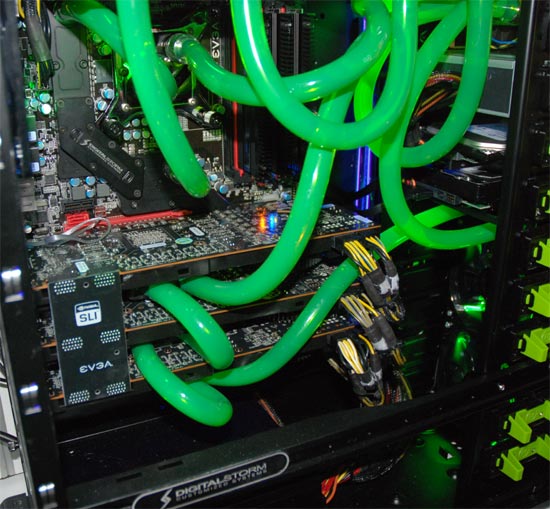http://translate.google.be/translat...dissipation-thermique-tres-importante/468101/
300W? Not looking good...
300W? Not looking good...
Given that we are here to speculate, how many cables you see in those pictures?
'Cause to me they seem more than 14... It seems like there are 2 cables per pin at least in the two pins at the top.

It's probably a cable branch connector it's being plugged in the 8-pin contact.
http://translate.google.be/translat...dissipation-thermique-tres-importante/468101/
300W? Not looking good...
Here's a question:
Okay, let's say Fermi is 5870 fast and no more. With the added physics would it also be 5870 + 8800GTS for PhysX fast?
Remember the old Mantra: "it's smaller than GT200 and it will be here by Christmas, Charlie is a liar!"Three PEGs? That's a whole lot of power for a chip that "isn't much more than a GTX280".
What do you mean? Would enabling PhysX suddenly create more breathing room on the GPU?
that PSU only has 6XPCI-e connectors; 4 x 6-Pin,2 x 8/6-Pin(only 17a per rail too,hello lock up...)so they must have Molex converters to finish it out, or a custom PSU... If they are 6+8pin cards, as the pic shows?But all three have double wires on the 8-pin...one should have only one unless they only had a 4x cable.
No, of course not. I'm talking about getting the equivalent of a 5870 + a good PhysX card on one card as a way for NV to position the card. Right now you have to have a second card and hacked drivers to run PhysX on Cypress. Also (and I don't know) does PhysX lower framerates on a 285 when enabled or does it come free?
Edit: Oh, and I like the sig change
As far as I understood the whole discussion here, there won't be much difference between A2 and A3. A3 was just something to kill time. Waiting for TSMC to improve yields.hmm, could this particular power arrangement be a result of the cards being A2, and A3 will have typical 2x3/4, 6 and 8pin?
So there you have it. Fermi is faster per clock than Cypress (but can't clock as high owing to power) and beats it handily with PhysX enabled unless you have another card for PhysX (and hacked drivers).
Edit: which is pretty darn good if PhysX takes off and, engineering-wise, pretty nifty.
Much of the last six pages looks like a weird typo. Sigh.
Are a bunch of you just hastily finishing off a gross excess of eggnog? Is someone pumping testosterone into the water? Why has this thread degenerated into 70% impassioned limb flailing, 20% snark, and 10% legitimate attempt at discovery?
So there you have it. Fermi is faster per clock than Cypress (but can't clock as high owing to power) and beats it handily with PhysX enabled unless you have another card for PhysX (and hacked drivers).
Edit: which is pretty darn good if PhysX takes off and, engineering-wise, pretty nifty.
I don't know how you could compare Cypress and Fermi clock for clock, the former only has one frequency domain, the latter has 2...
Sure, Fermi with 850MHz ROP domain and 1700MHz hot clock would be very competitive, but it simply is unrealistic and has nothing to do with reality.
ATM, we don't know where Cypress bottlenecks are, but Fermi has at least one too, we must wait to see where they are and whether or not they will hinder each GPU in game shaders processing.
Sure, but since I'm quite pragmatic I just say it would be that way, so not really clock for clock. At these clocks it would probably eat somewhere around 400watt...Albeit not directly comparable I can see Cypress yielding under 40nm the exact same 4890 frequency under 55nm (with over twice the complexity). Now give me one good reason why a GF100 with 3.08B transistors under 40nm would easily yield something like 850/1870 (given a rough 2.2x ALU:TMU ratio), when the GT200b with 1.4B transistors under 55nm was still at 650/1470?
